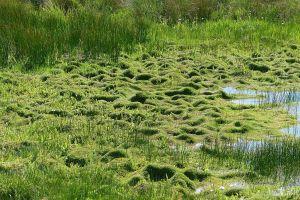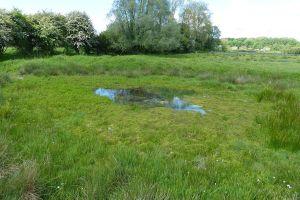
Hydra. Seba Albertus (1734-1765). Image from Wellsome Trust
A contribution by Claire Wordley of Conservation Evidence.
—
The Australian swamp stonecrop (Crassula helmsii) is a small, unassuming looking plant with incredible resilience. It can survive both baking heat and freezing cold; it can live underwater, on the water’s surface and on land; it can survive being dried out, bleached and sprayed with hot foam; and it can regenerate from tiny fragments. Unfortunately, in the UK and elsewhere in Europe it is an invasive species, choking the oxygen from ponds and shading out other plants with knock-on effects for entire freshwater ecosystems.
Swamp stonecrop, also known as New Zealand pigmyweed, was first introduced to the UK from Tasmania in 1911 and sold in garden centres from 1927 as an ornamental pond oxygenator. Shockingly, despite being documented as an invasive plant in New Forest ponds as early as 1976, its sale in the UK was only banned in 2014. Crassula appears to be spread mostly by people, whether deliberately or accidentally; it appears to be concentrated around car parks, residential areas and areas where equipment such as fishing gear is likely to have come from an infected site. Nearly 20% of 700 UK waterbodies surveyed contained the weed. Since every 10% increase in Crassula corresponds to a 5% decrease in native vegetation, and negative effects of Crassula invasion have been documented for zooplankton, macro-invertebrates and fish, with possible negative impacts on amphibians as well, control and ideally eradication is clearly needed. But what works to destroy this superweed?
Killing the hydra

Crassula helmsii (photo by Benjamin Blondel)
Like the seven-headed hydra of legend, Crassula helmsii seems able to regenerate after even harsh treatment and being shattered into tiny pieces. Documenting clearly what works to control this beast – and what does not – is critical. This work has recently been completed by Conservation Evidence at the University of Cambridge, as part of an ongoing series on controlling freshwater invasives. The team has worked to collect all the evidence on different ways of killing Crassula, and experts have scored these for their effectiveness (or otherwise).
One of the most effective ways to knock back Crassula appears to be applying herbicides, particularly glyphosate and diquat or diquat alginate. While each of these performed well to reduce Crassula in many trials – and the use of glyphosate and diquat together led to a 98% reduction in one trial – there are concerns that while the medicine could cure the disease, it could kill the patient. One study in the New Forest noted that native plant cover fell in the treatment sites at a greater rate than in the control sites, and glyphosate appears to be toxic to amphibians. There might also be adverse effects on some bird species, although this could be due more to habitat-level changes than direct toxicity, because other birds appeared to benefit from wetlands being sprayed with glyphosate.

Crassula helmsii (photo by Benjamin Blondel)
Covering the offending plant with black sheeting or carpet strips might, where feasible, provide an alternate approach. While the evidence for the effectiveness of keeping Crassula in the dark is not as strong as the evidence for spraying it, five studies showed promising results that light-proof barriers can eradicate or severely reduce the coverage of the weed. Sadly, on two sites Crassula recolonised after it was eradicated – indicating that controlling the spread of this plant is likely to be an uphill battle for some time to come. Flooding contaminated ponds with salt water also appears effective at killing Crassula, but salt concentrations need to be high, as it can survive in brackish water. The lethal effects of salt water are likely to be experienced by native flora – and in some cases fauna.
Since Crassula appears to be mostly spread by people, often on equipment such as nets and rods, effective biosecurity measures to stop the spread will be critical to maintaining areas free from this relentless invasive. Crassula survives drying well, but a 15 minute immersion in 45 °C water led to mortality in 90 % of the plants by one hour after treatment. Experimenting with hotter temperatures and longer immersion times might improve this further.
Treatments to forget
Unfortunately, not all the methods that have been trialled to get rid of Crassula have proven effective. Since Crassula, like other aquatic plants, needs light to grow, aquatic dyes that reduce the light available to submerged plants seemed like a good idea. Unfortunately, in a trial in the New Forest, this proved to be a non-starter, with Crassula cover increasing slightly in dyed pools. Hot foam was another inventive idea – foam stays in contact with the plant for longer than hot water, rupturing the cells of the leaves. Unfortunately, this was totally ineffective in one trial, and largely ineffective in another, meaning that this treatment will not be rolled out to a pond near you any time soon. Bleach was another failed treatment – adding hydrogen peroxide to tanks containing Crassula did not have sufficient controlling effects to merit field testing where other plants and native wildlife could be damaged by the chemical. Grazing was also rated as likely to be ineffective or harmful – trials showed varying results, but Crassula cover actually increased in grazed plots in one trial, and did not vary between grazed and ungrazed plots in the other trial.
Go forth and test
As ever, there are treatments out there that have not yet been tested sufficiently (or at all) – some of which could later prove to be effective. It is up to conservation practitioners who use these methods to test them experimentally and publish the results where they can be accessed by others, enabling the whole community to learn from each manager’s experience.

Spreading Crassula with equipment & clothes such as rubber boots. Dipping boots in hot water can kill the beast.
Combining treatments such as spraying and covering plants with light-proof barriers is one method that needs more testing. Other suggestions range from using liquid nitrogen or flame throwers, to using fungal-based herbicides and educating the public about the need to decontaminate clothes and equipment between ponds.
Whatever methods people are using to get rid of this plant, it is clear that rigorous collection of more data is needed — on what works to kill Crassula, on what methods lead to an increase in native plant cover, and on what the effects of treatment are on freshwater fauna from zooplankton to fish, frogs and birds. Trials do not need to be huge to help build our knowledge base, as long as they are well designed – in conservation science, truly every little counts.
What next?
Conservation Evidence will continue to add species to the freshwater invasives synopsis, which already contains 139 actions on American bullfrog, Asian clams, brown and black bullheads, floating pennywort, Ponto-Caspian gammarids, Ponto-Caspian gobies, Procambarus crayfish, red-eared terrapin, skunk cabbage, water primrose and now Crassula helmsii. The synopsis will hopefully stimulate action to fill in the knowledge gaps, making invasive species control more effective. When the synopsis is updated in a few years’ time, we hope that the evidence base will be much stronger. If not, we could see more ecosystems wrecked beyond repair.

http://www.conservationevidence.com

